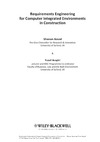Efficient communication, collaboration, data exchange and sharing are crucial for the success of today's many multi-disciplinary and interdisciplinary work environments. The implementation of computer integrated environments (CIE) is increasing and the requirements engineering necessary for the development of these systems is critical.
Requirements Engineering for Computer Integrated Environments in Construction provides an important source of information and advice for organizations needing bridge the gap between users and developers in the implementation of computer integrated solutions as well as for consultants providing services to their clients in CIE development.
The framework explained in the book is comprehensive and accessible. It provides a set of tools and techniques enabling readers to design, manage and deliver effective CIE-type systems in any complex organization – from construction and manufacturing to the information technology and service sectors. Construction companies for example, can use the framework provided to implement building information modelling to manage the diagnosis, planning, implementation and monitoring stages in BIM adoption.
Based on real experiences and lessons learned from many years of system development, this book offers an excellent resource for researchers and postgraduate students interested in CIE development for all multi-disciplinary and interdisciplinary work environments.Content:
Chapter 1 Introduction (pages 1–11):
Chapter 2 Requirements Engineering in Software Development (pages 13–39):
Chapter 3 Computer Integrated Environments (pages 41–76):
Chapter 4 Requirements Engineering in CIE Development for the Construction Industry (pages 77–96):
Chapter 5 Evaluation of Requirements Engineering Processes (pages 97–125):
Chapter 6 Requirements Engineering Approach in the Case Study Projects (pages 127–151):
Chapter 7 Evaluation of the Requirements Engineering Practices (pages 153–181):
Chapter 8 Mastering the Requirements Engineering Practices (pages 183–207):
Chapter 9 Evaluation of the Proposed Requirements Engineering Framework (pages 209–221):
Chapter 10 Summary and Conclusion (pages 223–228):
 |
|
О проекте
|
|
О проекте


